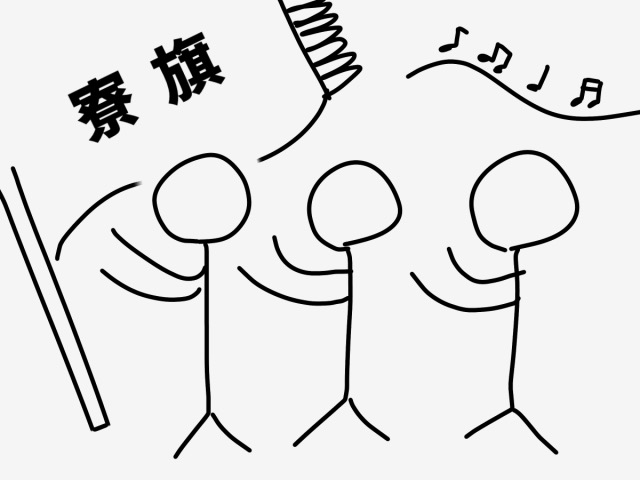
Firsthand account reveals it’s not all pillow fights and gossip sessions.
Like many countries around the world, students in Japan have the option to live in a dormitory while studying at university. That was the case for our reporter Saya Togashi, who lived in a women’s dormitory when she was at uni, and according to her, it wasn’t an idyllic setup where young women exchanged clothes and love stories. It was a tough time for her, as it is for many students who may not be suited to communal living arrangements, so she’d like to pull the curtain back and share with us what it was really like to live there.
▼ For starters, it wasn’t like this.
Saya says it was a couple of decades ago when she lived at the dorm, but given that the traditions and rules had already been in place for years before she was there, she doubts whether a lot would have changed in the years since. Of course, dormitories may differ depending on the setup, but Saya belonged to a “self-governing dormitory“, where the management was entrusted to the hands of the students, with no external supervision from an adult such as a dormitory superintendent or manager. At the time, the legal age of adulthood was 20, and although it’s since been lowered to 18, the idea of truly becoming an adult at age 20 is still prevalent in society, due to the annual nationwide Seijin no Hi (Coming of Age Day) public holiday, where those who turn 20 take part in special seijinshiki celebrations.
In a self-governing dormitory, the student representatives form a self-governing association, and they also clean the house themselves. Only meals were prepared by external cooks in the form of a consignment arrangement by the residents’ association.
The living room was a four-person room with bunk beds, and it was designed to mix grades as much as possible. The dormitory fee was about 25,000 yen (US$171.78) a month, which was surprisingly cheap, even by standards of the time.
▼ Saya’s room in the dorm.
The dormitory had a long history dating back to the Showa period (1926-1989), and the building was so old that stories of ghosts were commonly told. However, it’s the many traditions, passed down from generation to generation, that stay with Saya to this day.
The first of these traditions was what she calls “Learning Stunts“. The acquisition of these “stunts” was the first obstacle that new students had to overcome, and though they might consist of short plays and recreational activities, similar to what you’d find in a Boy Scout’s organisation, in Saya’s dormitory, they were dances.
New students had to learn the dormitory song that had been passed down in the dormitory for generations and the choreography for dancing to the music. Then they would perform these dances in large groups at seasonal events.
For a while after entering the school, Saya often had to rush back to the dormitory and practice the dance straight after her lectures. Even those who might prefer to go off to their part-time jobs or club activities had to participate in dance practice.
▼ No time for anything but dance.
Following the examples of the “senpai”, or senior students, Saya practiced the dance day after day, and she and her fellow students were desperate to learn the steps because practice would never end until they’d memorised the choreography.
Looking back on it now, Saya believes the purpose of these stunts is probably to strengthen the bond between new students and help them to become friends, and it seems that some youth hostels and rider houses (super budget dorms in Japan) still have similar customs.
Once they’d learnt the steps, Saya and her fellow dorm residents were required to perform at numerous events, so a lot of time was spent on planning additional things like singing, drama, and one-shot performances. Though at the time Saya didn’t think the whole dance thing was worth anything, she can see the benefit it might have in training students to work together in teams when they enter the corporate world, and it might come in handy for any performances they might face at company bonenkai (year-end parties).
▼ Saya dutifully dancing with the other dorm residents.
One of the most surprising things Saya came across was the bathing etiquette at the dorm. The dormitory had a large public bath, and it was supposed to be used within a set time. When entering the large public bath, new students were required to speak loudly, almost like a cheerleader, towards the people already in the bathing area. Both parties would be naked at the time, of course.
Saya remembers having to open the glass door of the bathing area and announce who she was and where she was from, shouting, “I’m from xxx high school in xxx Prefecture! I’m a first-year undergraduate! Saya Togashi is entering!!” This procedure was known as “Storm”, and its roots appear to stem from student activities during the old high school days of yore.
▼ People in the bath would reply “Yo-o!” or “Yo-shi!” (“okay” or “good”) and only after receiving this answer were students then allowed to enter the bathing area.
Both “Stunts” and “Storm” were remnants from a time when university life was seen as a social and ideological collective. Sharing patterns of behaviour like this were said to increase unity and solidarity amongst students.
However, it was a big culture shock for Saya. This was neither an employee dormitory nor a sports team dormitory, and even though they all went to the same university, there were thousands of students, so in the grand scheme of things the only thing the dorm residents had in common was that they lived in the same house. She didn’t feel that these patterns of behaviour would unite all the students, so much as make other students feel as if the dormitory women were in a separate group to them.
▼ Now we move on to another practice in solidarity with Compulsory Joint Parties.
There were many events in the dormitory and everyone was expected to participate so there was no option to be absent. Just some of the parties Saya remembers are the “welcome party for new students,” the “year-end party,” and the “farewell party”, which were held jointly every year with the nearby men’s dormitory.
For Saya, these parties all took place in an era when students weren’t really using mobile phones so the only way to get in touch with anyone you were interested in was to call the dormitory. There was a “telephone room” in the dormitory, and students took turns answering the phone. When a call would come in from the outside, a hall announcement would be made, so everyone could hear who was calling and how many times they’d called.
▼ No sliding into the DMs back in those days.
After the welcome party for new students, there would commonly be a “phone rush”, with announcements being made left right and centre. This would make it clear as to which women in the dorm were being constantly called, and Saya would overhear senior students discussing it, saying things like, “I see xxx is number one this year”, which turned it into some sort of popularity contest. As time went on, word of who ended up in a relationship after these parties would spread at the speed of light through the senior student network.
Saya’s least fond memory of dorm life, however, came at the end, after she moved out of the dormitory.
Though she could understand that the rostered household chores such as cleaning duty, newspaper duty, and telephone duty, made sense, and some of the stricter rules, such as the ones at the cafeteria, where they were limited to one bowl of rice and weren’t allowed any refills, were designed for the good of the group, she just couldn’t get used to the rather rigid environment at the dorm, no matter how hard she tried.
At first, she thought she might have to quit university altogether, but in the end, she decided to move out of the dorm before finishing her degree. In order to move out early, she had to submit a letter of apology with an explanation, and then she was able to leave the dormitory.
While she was glad to have moved out, Saya later heard through the grapevine that after she left, her handwritten apology was posted for a while in the toilet used by all the dormitory students.
Though Saya’s time at the dorm was less than idyllic, her seniors were very proud of the traditions of the dormitory, and she says there was no violence or abusive language while she was there. It was clear that none of the rules were meant to be spiteful or to throw juniors under the bus, so to speak, but to promote unity and preserve tradition.
The majority of students became used to this type of environment, made lifelong friends, and stayed there until graduation. Saya believes she just didn’t have the right mentality for that type of lifestyle.
Saya also heard that these days, the dormitory rooms are now private rather than shared, and even have their own kitchen and coin-operated shower, and the communal dining room doesn’t exist anymore. She thinks this would make living there easier now, although she still wouldn’t be able to stand all those longstanding traditions.
Featured image: Pakutaso
Insert images © SoraNews24, Pakutaso (1, 2, 3)
● Want to hear about SoraNews24’s latest articles as soon as they’re published? Follow us on Facebook and Twitter!
[ Read in Japanese ]









 How Japanese universities are trying to help worried parents by babying their students
How Japanese universities are trying to help worried parents by babying their students The top five surprising observations of a Japanese student visiting an American university
The top five surprising observations of a Japanese student visiting an American university Japanese reporter interviews college students to find out why anyone would study Japanese
Japanese reporter interviews college students to find out why anyone would study Japanese Five tips for hosting a college-age Japanese student in your country
Five tips for hosting a college-age Japanese student in your country Kyoto karaoke joint is like a dystopian city
Kyoto karaoke joint is like a dystopian city Starbucks Japan ready to get Year of the Horse started with adorable drinkware and plushies【Pics】
Starbucks Japan ready to get Year of the Horse started with adorable drinkware and plushies【Pics】 Japanese thug wear from Birth Japan perfect for those breaking bad next year
Japanese thug wear from Birth Japan perfect for those breaking bad next year 7-Eleven Japan’s ramen-cooking robot whipped us up a bowl of noodles【Taste test】
7-Eleven Japan’s ramen-cooking robot whipped us up a bowl of noodles【Taste test】 Sumo Sanrio! Hello Kitty and pals team up with Japan Sumo Association for new merch【Pics】
Sumo Sanrio! Hello Kitty and pals team up with Japan Sumo Association for new merch【Pics】 Beautiful sightseeing boat is a floating tea ceremony venue in east Japan’s best hot spring town
Beautiful sightseeing boat is a floating tea ceremony venue in east Japan’s best hot spring town 7 great places to see Mt. Fuji from without having to climb it
7 great places to see Mt. Fuji from without having to climb it New Japanese menstrual product seeks to help women spot unidentified iron deficiencies
New Japanese menstrual product seeks to help women spot unidentified iron deficiencies Top Secret Cookie Recipe Finally Comes to Light
Top Secret Cookie Recipe Finally Comes to Light Beautiful Starbucks in Kyoto blends into its traditional landscape in more ways than one
Beautiful Starbucks in Kyoto blends into its traditional landscape in more ways than one Japanese Twitter obsessed with app that revives the VHS camcorder recording quality of the ‘80s
Japanese Twitter obsessed with app that revives the VHS camcorder recording quality of the ‘80s Disillusionment at Tsukiji’s tourist-target prices led us to a great ramen restaurant in Tokyo
Disillusionment at Tsukiji’s tourist-target prices led us to a great ramen restaurant in Tokyo Japan may add Japanese language proficiency, lifestyle classes to permanent foreign resident requirements
Japan may add Japanese language proficiency, lifestyle classes to permanent foreign resident requirements Lacquerware supplier to emperor of Japan and Pokémon team up for new tableware
Lacquerware supplier to emperor of Japan and Pokémon team up for new tableware Starbucks Japan releases new zodiac chilled cup drink for 2026
Starbucks Japan releases new zodiac chilled cup drink for 2026 Cyberpunk anime meets traditional culture in Ghost in the Shell gold leaf Japanese changing screens
Cyberpunk anime meets traditional culture in Ghost in the Shell gold leaf Japanese changing screens Hello Kitty Choco Egg figures are an adorable trip through three periods of Japanese pop culture【Pics】
Hello Kitty Choco Egg figures are an adorable trip through three periods of Japanese pop culture【Pics】 Japan’s otoshidama tradition of giving kids money at New Year’s gets a social welfare upgrade
Japan’s otoshidama tradition of giving kids money at New Year’s gets a social welfare upgrade Japan’s human washing machines will go on sale to general public, demos to be held in Tokyo
Japan’s human washing machines will go on sale to general public, demos to be held in Tokyo 7-Eleven Japan starts new temporary luggage storage service in over 300 branches
7-Eleven Japan starts new temporary luggage storage service in over 300 branches Starbucks teams up with 166-year-old Kyoto doll maker for Year of the Horse decorations【Photos】
Starbucks teams up with 166-year-old Kyoto doll maker for Year of the Horse decorations【Photos】 Tokyo considering law requiring more trash cans following litter increase in heavily touristed area
Tokyo considering law requiring more trash cans following litter increase in heavily touristed area Tokyo’s Tsukiji sushi neighborhood asks tour groups to stay away for the rest of the month
Tokyo’s Tsukiji sushi neighborhood asks tour groups to stay away for the rest of the month Nintendo’s Kirby now delivering orders at Kura Sushi restaurants, but not in Japan
Nintendo’s Kirby now delivering orders at Kura Sushi restaurants, but not in Japan Tokyo event lets you travel back in time, for free, to celebrate 100 years since Showa era start
Tokyo event lets you travel back in time, for free, to celebrate 100 years since Showa era start Sanrio theme park in Japan announces plans to expand into a Sanrio resort
Sanrio theme park in Japan announces plans to expand into a Sanrio resort Stamina-destroying “Paralysis Noodles” are Tokyo’s newest over-the-top ramen innovation
Stamina-destroying “Paralysis Noodles” are Tokyo’s newest over-the-top ramen innovation Survey asks foreign tourists what bothered them in Japan, more than half gave same answer
Survey asks foreign tourists what bothered them in Japan, more than half gave same answer Japan’s deadliest food claims more victims, but why do people keep eating it for New Year’s?
Japan’s deadliest food claims more victims, but why do people keep eating it for New Year’s? We deeply regret going into this tunnel on our walk in the mountains of Japan
We deeply regret going into this tunnel on our walk in the mountains of Japan Studio Ghibli releases Kodama forest spirits from Princess Mononoke to light up your home
Studio Ghibli releases Kodama forest spirits from Princess Mononoke to light up your home Major Japanese hotel chain says reservations via overseas booking sites may not be valid
Major Japanese hotel chain says reservations via overseas booking sites may not be valid Put sesame oil in your coffee? Japanese maker says it’s the best way to start your day【Taste test】
Put sesame oil in your coffee? Japanese maker says it’s the best way to start your day【Taste test】 No more using real katana for tourism activities, Japan’s National Police Agency says
No more using real katana for tourism activities, Japan’s National Police Agency says The top 10 annoying foreign tourist behaviors on trains, as chosen by Japanese people【Survey】
The top 10 annoying foreign tourist behaviors on trains, as chosen by Japanese people【Survey】 Starbucks Japan reveals new sakura drinkware collection, inspired by evening cherry blossoms
Starbucks Japan reveals new sakura drinkware collection, inspired by evening cherry blossoms Love yakiniku but dining solo? Here’s what it’s like to eat alone at Yakiniku Like
Love yakiniku but dining solo? Here’s what it’s like to eat alone at Yakiniku Like What it’s like to live in Tokyo’s least safe neighbourhood
What it’s like to live in Tokyo’s least safe neighbourhood It’s Just Like a Handshake… 【You, Me, And A Tanuki】
It’s Just Like a Handshake… 【You, Me, And A Tanuki】 Does Japan really need company drinking parties?
Does Japan really need company drinking parties? What it’s really like to join a Japanese festival and carry a mikoshi around Tokyo for a day
What it’s really like to join a Japanese festival and carry a mikoshi around Tokyo for a day What it’s like to buy a canned railway stone in Japan
What it’s like to buy a canned railway stone in Japan Japan Travel: What it’s like to go on a solo journey on a Japanese restaurant train
Japan Travel: What it’s like to go on a solo journey on a Japanese restaurant train Japanese exchange student sparks culture debate on Twitter with comment about American clothing
Japanese exchange student sparks culture debate on Twitter with comment about American clothing What it’s like to rent a kimono and stroll around Sensoji temple in Asakusa for an afternoon
What it’s like to rent a kimono and stroll around Sensoji temple in Asakusa for an afternoon Attending Japanese women’s pro wrestling live for the first time ever–and having an absolute blast
Attending Japanese women’s pro wrestling live for the first time ever–and having an absolute blast Shimane has a secret hot spring town that feels like stepping into an old Japanese film
Shimane has a secret hot spring town that feels like stepping into an old Japanese film
Leave a Reply